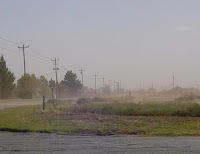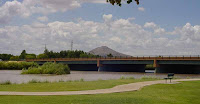I was hoping that I could find volunteer work here in Clovis by checking either the
newspaper or the
city web site. There didn’t appear to be any one central listing of volunteer opportunities. When I started asking the people I met, they told me that there are a great many volunteer opportunities, but that people find out about them through "word of mouth."
So I made a list for myself and for anyone else trying to figure out where to start in Clovis. Here is my list of organizations seeking volunteers, with the information and needs that they list on their web sites in italics. I will add to this list from time to time, as I discover other organizations looking for help.
Clovis Public Library: http://www.library.cityofclovis.org/volunteers.html
Volunteer requirements:
Volunteers must be at least 12 years old
A record of hours worked is kept
Applications are required
Applicants are interviewed
Projects can be selected
**********
Curry County Literacy Council:
http://www.clovis.edu/EducationalServices/CSS/cclc.asp
Goal and mission: “…to provide one with a sense of security to gain employment, have life skills, and assist in language development. It is our mission to help English-speaking adults and families improve their reading, writing, listening, speaking, numeracy and other life skills through programs adapted for the needs of the individual.”
What you can do to help:
Tutor basic literacy students
Tutor English as a Second Language students
Tutor students in need of Life Skills
Help plan special projects, such as Workplace Literacy or Family Literacy
Help promote awareness
**********
HOSTS program: http://www.cms.k12.nm.us/federal_programs/hosts.html
What it is: H.O.S.T.S (Help One Student to Succeed) is a federal program in the schools where students work with a mentor to help them succeed in reading.
· HOSTS is not a curriculum, but an instructional strategy designed to complement the existing curriculum.
· HOSTS provides assistance to students who need help developing reading skills using one-on-one mentoring by a community volunteer.
· HOSTS mentors provide role models who motivate, support, and provide individual attention for "at risk" students.
The program is looking for people who:
Enjoy working with children
Have 30 minutes to 1 hour one day per week to volunteer
Have a desire to Help One Student To Succeed
**********
United Way of Eastern New Mexico; Clubs, Civic, and Volunteer Opportunities
http://www.unitedwayenm.org/index.php?pr=211volunteer
This is the kind of listing I wish I had found at the beginning of my search. It will connect you with volunteer possibilities for everything from animal welfare to youth services.
**********
VistaCare (hospice) volunteer opportunities:
http://www.vistacare.com/giving/volunteering.asp
VistaCare provides a comprehensive program of care for individuals with a life-limiting illness. VistaCare offers a wide range of supportive services to terminally ill patients and their families. [The] staff not only treats physical pain and symptoms, but also provides emotional, social, and spiritual support for the individual and their loved ones. [They] also work collaboratively with area physicians and clinicians.
For volunteers: Training is provided and assignments are based on your interests and availability. You can choose to:
· Visit with patients and families to provide companionship
· Visit with a patient to provide the caregiver a time of respite
· Assist with basic maintenance, yard, and handy work at patients’ homes
· Prepare meals or run errands for patients
· Provide assistance with light housekeeping for patients
· Provide grief and bereavement support for families
· Assist in the office with administrative and clerical tasks
· Help recruit and train other volunteers
· Work in your own home making special items for patients
· Contribute your professional expertise
 There are as many ways to think about death as there are cultures. In my own culture (Anglo-Saxon New Englander roots), we tend not to talk about it too much. But think about the beliefs expressed in this poem* that was read at the funeral of a friend, who was given back to us with these words:
There are as many ways to think about death as there are cultures. In my own culture (Anglo-Saxon New Englander roots), we tend not to talk about it too much. But think about the beliefs expressed in this poem* that was read at the funeral of a friend, who was given back to us with these words: 













 Drawdown, or water use, of the aquifer occurs when agricultural, industrial, and residential users withdraw water for surface use. About 94% of the water is used for irrigation in areas that formerly were a part of the
Drawdown, or water use, of the aquifer occurs when agricultural, industrial, and residential users withdraw water for surface use. About 94% of the water is used for irrigation in areas that formerly were a part of the 


 The Owl has more seating, so you spend less time in line. On the other hand, the service is so quick that it seems you’ve been served and are on your way out the door almost before having time to savor the experience. The burgers are smaller than at the Buckhorn, but the meat has the best flavor I’ve ever tasted in a burger. The atmosphere is pure cowboy bar, as is the Buckhorn—you know you’re in the Wild West, and they aren’t putting on a show. The Owl has those great autographed-by-everybody-from-all-over dollars hanging all over the walls and the ceiling.
The Owl has more seating, so you spend less time in line. On the other hand, the service is so quick that it seems you’ve been served and are on your way out the door almost before having time to savor the experience. The burgers are smaller than at the Buckhorn, but the meat has the best flavor I’ve ever tasted in a burger. The atmosphere is pure cowboy bar, as is the Buckhorn—you know you’re in the Wild West, and they aren’t putting on a show. The Owl has those great autographed-by-everybody-from-all-over dollars hanging all over the walls and the ceiling.  For a lot of historical information about the Owl Café and some mouthwatering food photos, see Gil’s Thrilling Web Site, a wonderful place to roam around in search of New Mexico’s best food:
For a lot of historical information about the Owl Café and some mouthwatering food photos, see Gil’s Thrilling Web Site, a wonderful place to roam around in search of New Mexico’s best food: 












